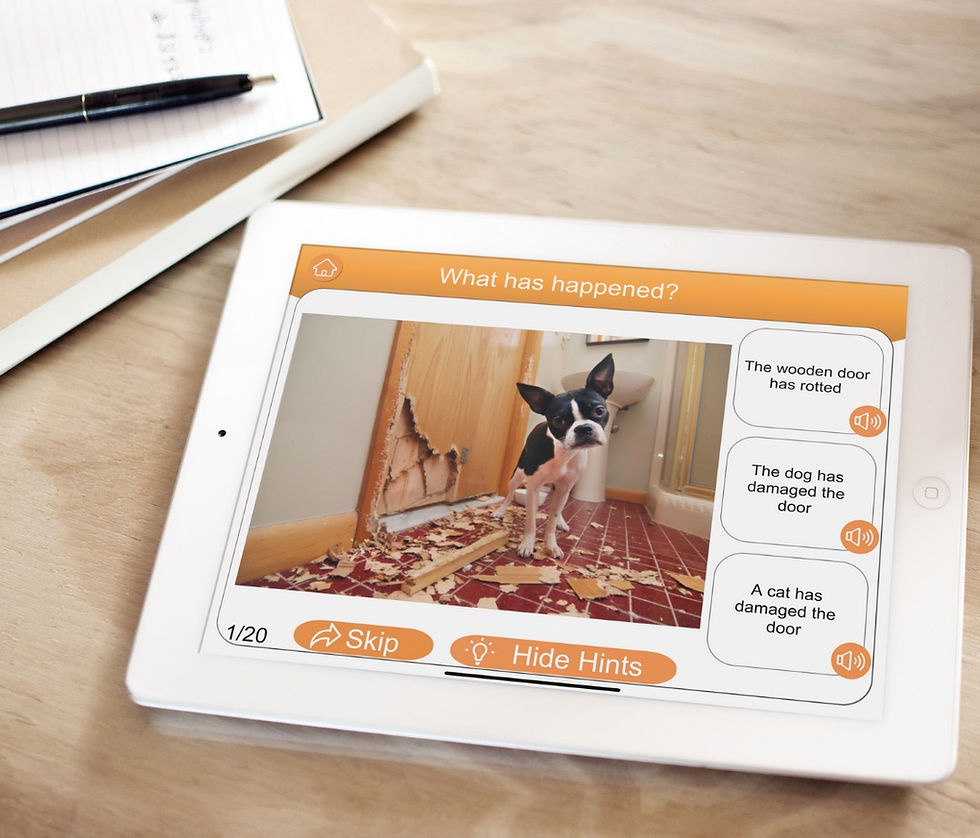Inference Pictures for Social Inferencing
- Lorraine Curran

- Apr 15, 2020
- 3 min read
Updated: Oct 28, 2020
Inference pictures are a great way to teach the ability to make social inferences. Making social inferences means understanding information that is inferred or not directly stated. It involves observing a situation, then using clues with background knowledge to figure out what has happened or what is happening.
The ability to make social inferences is an essential social skill. We make social inferences all the time but it is actually a very complex skill. Children with language delay, children with autism and adults with autism or brain injury often need extra support to learn how to read situations, decipher the clues and make a social inference.

Let’s take an example. Look at the picture of the dog and see if you can work out what has happened.
When you see this picture, you are able to pull all the pieces together and infer what has happened. You use your prior knowledge that dogs like to chew things. You find the clues in the picture; the dog, the damaged wooden door and the pieces of wood on the floor. You probably didn’t even need to consciously think about the inferences you made about the picture.
Making social inferences also includes drawing conclusions about how people may be feeling, what they may be thinking or saying and what they intend to do. These types of social inferences are more complex because they require the ability to read facial expressions and body language.
Over 300 Inference Pictures
Pictures of real-life situations are ideal for working on the ability to make social inferences. That’s why we decided to make Inference Pics, our inference app. Inference Pics includes over 300 inference pictures in seven activities with in-built inference prompts.

Inference activity 1: What has happened?
Inference activity 2: Jobs
Inference activity 3: Places
Inference activity 4: Seasons
Inference activity 5 : Feelings
Inference activity 6: Thoughts
Inference activity 7: Conversations
Teaching Inference Using Pictures in Inference Pics
Choose an activity and an inference picture. Each inference activity in the Inference Pics app has two inference prompts. The first question asks the user to make an inference e.g. What has happened? How are they feeling? etc. If they have difficulty answering, display the multiple choice options.
The second question in each inference activity is “How do you know?”. This allows the child or adult to explain what clues they found in the inference picture (e.g. body language, facial expression) and how they made the inference.
Choosing the Right Inference Pictures

Some inference pictures are easier than others. For example, inference pictures of seasons, people with different jobs, and everyday places will likely be easier for many individuals than inference pictures that require some ability to understand facial expression and body language.
Activities 6 and 7 (Thoughts and Conversations) in the Inference Pics app are more advanced as there is much more to infer in the inference pictures including how the people are feeling and what they may be saying.
Remember that the inference picture is the stimulus. Many children and young adults need explicit explanations in order to find the clues, and understand facial expressions and body language. In some cases, they may have more difficulty due to not having prior knowledge e.g. they may not know that people yawn when they are tired or that dogs like to chew things.
Inference Pics is available for $14.99/£14.99 on the AppStore and Google Play Store. Try the lite version, Inference Pics Lite for free.
Inference Pics is designed to be interactive. Together with the parent, clinician or teacher, the child or adult user will develop their ability to find social and contextual clues in the inference pictures as well as their understanding of facial expression and body language.
Watch Inference Pics in action to learn more about teaching inference with pictures:






Comments